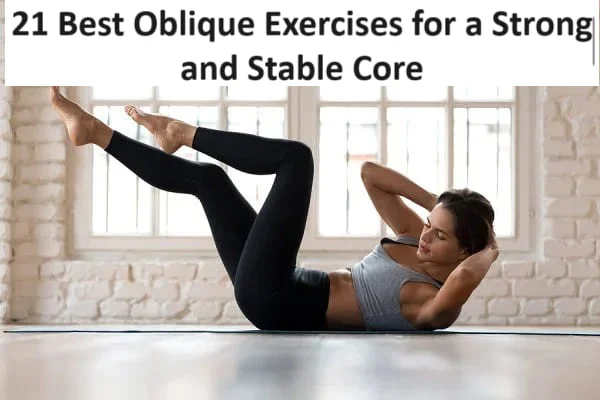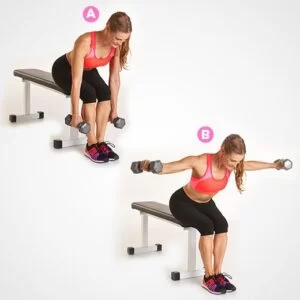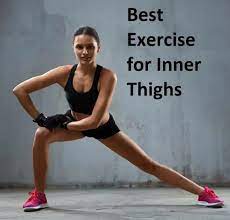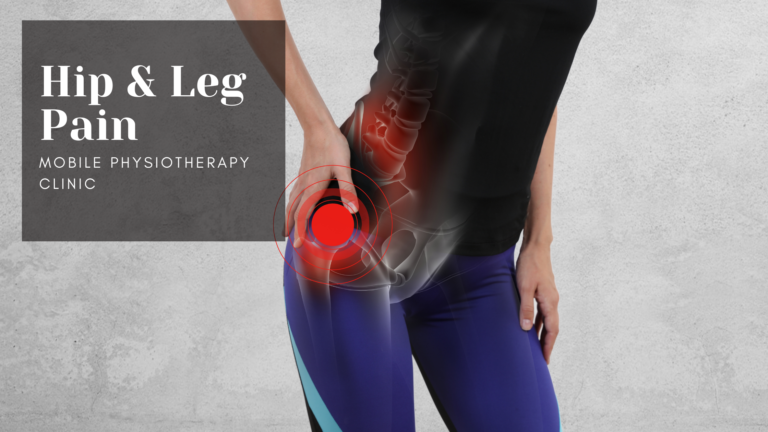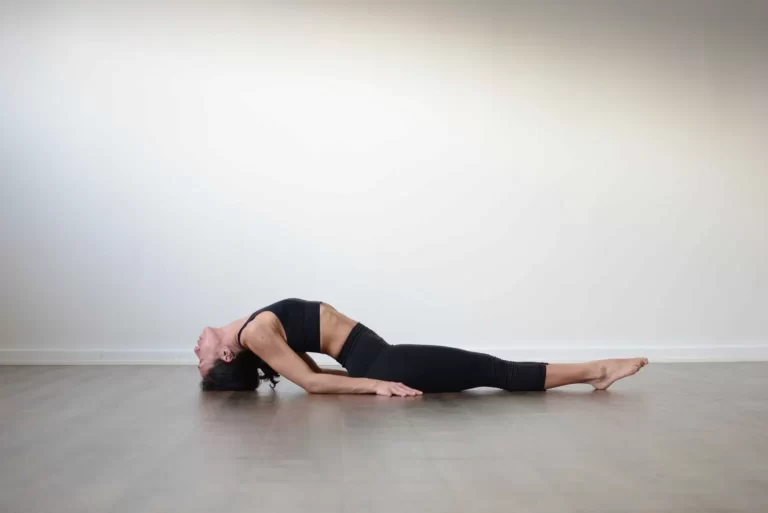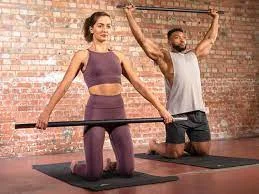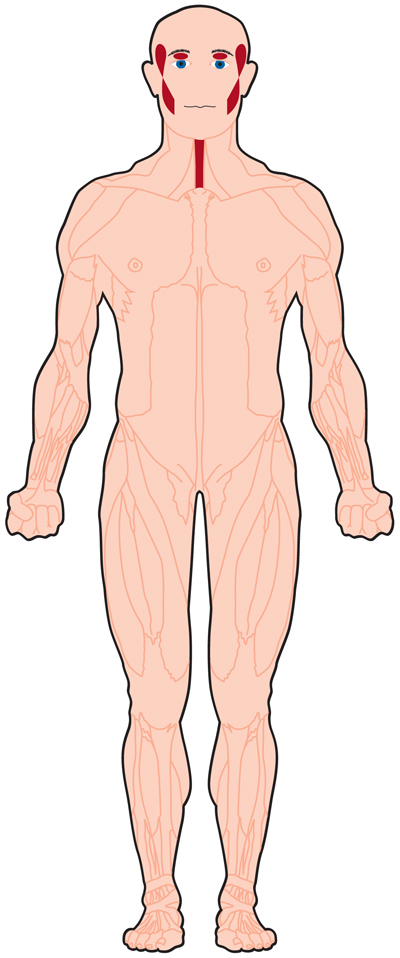21 Best Oblique Exercises for a Strong and Stable Core
Introduction
A resilient core is the cornerstone of a powerful and agile body, contributing to enhanced athletic performance and everyday functional movements. The often-neglected oblique muscles, situated on the sides of the abdomen, are vital for maintaining stability, controlling rotational movements, and promoting overall balance. Strengthening these muscles is paramount not only for achieving a toned physique but also for cultivating the strength required to excel in various physical activities.
This article is dedicated to exploring effective strategies and exercises that specifically target the obliques, empowering you to enhance your core strength and fortify your body’s foundational support system. By integrating these targeted exercises into your workout routine, you can unlock the full potential of your oblique muscles, enabling you to conquer new fitness milestones and unlock your body’s true strength and agility.
What is oblique muscle?
The oblique muscles, also known as the obliques, are a group of abdominal muscles located on the sides of the abdomen. There are two sets of oblique muscles on each side of the body: the external obliques and the internal obliques.
- External Obliques: These muscles are the largest and most superficial of the oblique muscles. They originate from the lower eight ribs and are inserted into the linea alba (a fibrous band in the midline of the abdomen) and the iliac crest (the upper edge of the hip bone). The external obliques run diagonally downward and medially, forming a “V” shape. They are responsible for flexing and rotating the trunk, as well as compressing the abdominal contents.
- Internal Obliques: The internal obliques lie underneath the external obliques, running in the opposite direction. They originate from the thoracolumbar fascia (a fibrous sheet on the lower back), the iliac crest, and the inguinal ligament (a band of connective tissue in the groin area). The internal obliques insert into the linea alba, pubic crest (the upper border of the pubic bone), and the lower ribs. These muscles play a similar role to the external obliques, assisting in trunk flexion, rotation, and compression.
Both sets of oblique muscles work together to provide stability and support to the core, which is crucial for maintaining proper posture, balance, and movement. They also contribute to activities such as bending sideways, twisting, and turning the torso. Additionally, strong obliques can enhance sports performance and help prevent injuries by improving overall core strength.
To target and strengthen the oblique muscles, exercises like side plank variations, Russian twists, bicycle crunches, and woodchoppers can be performed. It is important to note that proper form and technique should always be maintained to avoid straining the muscles or causing any discomfort.
Strengthening exercise of obliques
Following are the strengthening exercises of the External and Internal oblique muscles.
Bird dog
This exercise focuses on your abs and will also examine your balance. Other than the obliques, it also works the:
lats
glutes
In order to do this exercise follow the below steps

- Get started on all fours, with your hands aligned with your shoulders and your knees in sync with your hips.
- Do the inhalation, engage your core, and take your right arm and left leg straight out so they’re both parallel to the surface of the floor.
- Make sure that your lower back remains stable and your hips remain square to the floor.
- Do the exhalation and go back to initiate positions.
- Perform again with the left arm and right leg.
Heel tap
Focuses your obliques with this move, which is basically a side crunch on the floor.
In order to do this exercise follow the below steps
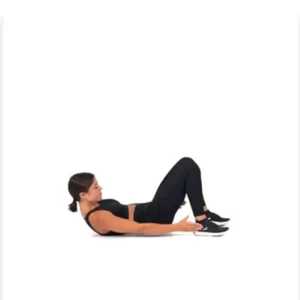
- Start with lying on your back on the floor your knees should be bent and your feet should be flat.
- Your arms should be down by your sides and your palms should be facing upward or downward according to your preference.
- Take a deep breath and use your core muscles to raise your head and upper back off the floor.
- Touch your heel with your left hand as you reach toward your left side.
- Imagine this movement as a side crunch, and resist the urge to raise your upper body further off the floor.
- Come back to the center.
- Do it again on the right side.
Side plank
Whether on your knees or your feet, this exercise not only focuses on your side abs but also your upper body and one of the muscles in your booty called the gluteus medius, an essential stabilizer for your pelvis bone.
Other major muscles worked include the:
shoulder
gluteus medius
In order to do this exercise follow the below steps

- Start with lying on the floor on your left side.
- As you stabilize your upper body, raise your hand or forearm.
- Do the bending of your knees at a forty-five-degree angle and place your right leg on top of your left.
- You can also extend your legs and place your feet if you have enough strength.
- Your body should create a straight line from either head to knee or head to toe, whichever setup you choose.
- Maintain your feet connected, use your obliques to pull your right hip in the direction of the sky, permit your right arm to rest on your side, or do the overhead exercise.
- Maintain here for the desired time, then change sides.
Side plank with a reach under
Adding a reach-under will give you a significantly more twisting action for focusing on those obliques.
Other major muscles worked include the:
shoulder muscles
gluteus medius
In order to do this exercise follow the below steps
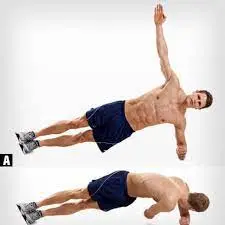
- Start with lying on the floor on your left side.
- Positioned up onto your hand or forearm, supporting your upper body.
- Bend your knees at a forty-five-degree angle and place your right leg on top of your left.
- Maintain your feet connected, and use your obliques to pull your right hip in the direction of the sky.
- Do the extension of your left arm overhead.
- Take a deep breath, and reach your hand down and under the left side of your body, adding in that twist.
- Take back your arm overhead, then do it again.
Cross-body mountain climber
Mountain climbers, who often practice it as a kind of cardio, additionally focus on the core, specifically the obliques. To concentrate fully on the abs, go slower than you would for a cardio mountain climber.
Other major muscles worked include:
delts
triceps
quads
In order to do this exercise follow the below steps
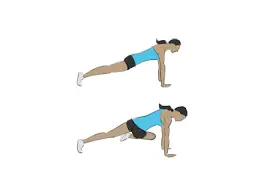
- Begin in a high plank position, but with your glutes, a little raised than they would be in that position.
- Wrists should be under your shoulders and your neck should be in a neutral position.
- Move your left knee forward toward your right elbow, and maintain the rest of your body stationary.
- Come back to the initiate position, then do it again with the right leg.
Bicycle crunch
This rotating ab move will have your obliques on fire. Another positive aspect is that it is scalable. If you have difficulty maintaining your lower back flush to the floor, put your feet on the floor instead of extending your legs.
In order to do this exercise follow the below steps

- Start with lying on the floor on your back, and take your legs to a tabletop position.
- Bend your elbows and put your hands back side of your head.
- By using your core, raise your head, neck, and shoulders off the floor, and take your right elbow to your left knee, straightening your right leg.
- Release a little bit and turn to the other side, bending your right leg, straightening your left leg, and taking your left elbow to your right knee.
Standing core stabilizer
Do not neglect the benefit of this standing ab movement. make sure that you are rotating your whole torso, not just your arms, in order to get the full benefit.
In order to do this exercise follow the below steps
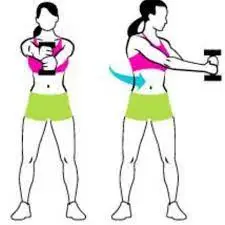
- Start with standing straight and your feet about shoulder-width distance, and take your arms straight out in front of you, hands connected.
- Engage your core and start turning your upper body to the left side, leading with your hands and permitting the right toe to pivot in response.
- Your gaze should follow this movement.
- Come back to the center and do it again for the desired number of repetitions, then do it again on the right side.
Wide side crunch
With this motion, you may incorporate some leg exercises into your side crunches. The emphasis here is on the obliques, so if your legs tire, come out of the squat slightly.
Other muscles worked include:
quads
glutes
In order to do this exercise follow the below steps
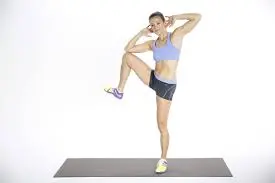
- Begin with a wide stance with your toes pointed out.
- Take a squat position, and raise your arms out to your sides with your elbows bent at a 90-degree angle.
- Maintaining the squat position, bend at your side, and bring your right elbow in the direction of your right knee.
- Come back to the center and crunch to the left.
Standing knee tuck extension
Perform standing side crunches with standing knee-tucked extensions.
To achieve the most crunch for your buck, reach your elbow to the knee while concentrating on the side bend.
In order to do this exercise follow the below steps
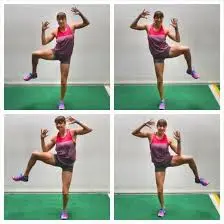
- Start with standing and your feet wider than shoulder-width distance and your toes pointed out.
- Bend your elbows and put your hands back side of your head.
- Engage your core and bend sideways at the waist, take your knee up and your elbow down simultaneously.
- Come back to the center and do it again on the other side.
Walking lunge with rotation
When you add a turning to an exercise, you can count on your obliques working. Walking lunges can be made more interesting by twisting your torso over your front leg.
Other muscles worked include:
quads
glutes
hamstrings
In order to do this exercise follow the below steps
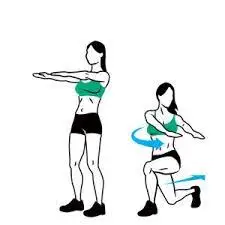
- Begin with standing straight your feet should be together your arms should be out in front of you, elbows must be bent at ninety degrees.
- Lunge in the forward direction with your left leg until your thigh comes parallel, and turn your torso over your left thigh to hit the oblique.
- Come back to the initiate position, and rotate your torso back to the center.
- Step forward with the right leg, and do again the movement.
Pall of Press
Because the Pallof press is an anti-rotation movement, the objective is to maintain your body completely locked in. Consider this a full-core motion that involves the entire unit.
In order to do this exercise follow the below steps
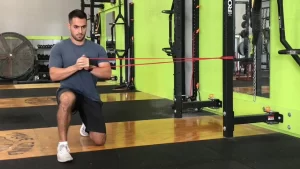
- Start with standing or kneeling next to a cable machine or a resistance band tethered to a low anchor point.
- Set up a sufficient distance from the anchor point to create tension.
- keep the handle of the cable or the band in your hands engage your core and compress your glutes.
- Extend your arms out, dealing against the rotational force to keep your torso stable.
- After few a counts, come back to the initiate position.
Windshield Wipers
In order to do this exercise follow the below steps
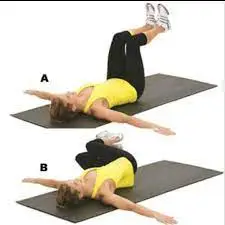
- Begin with lying down on your back, facing the ceiling with your knees up in the air at ninety degrees.
- You can anchor yourself with your arms spread out or by your sides.
- Turn your knees to the right just as you are going to touch them to the surface of the ground.
- Descend them until you feel yourself struggle a bit.
- Come back to neutral and do it again on the other side.
To make this exercise easier, maintain your heels on the floor—toes up in the air—and turn from there. To make it more difficult, straighten out the legs as much as you can.
Alternating V-Ups
In order to do this exercise follow the below steps
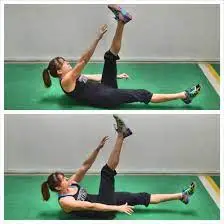
- Start with lying down on your back and stretch your arms out above your head.
- Maintain the legs straight.
- Take a deep breath and as you do exhalation, sit up and reach your right arm and raise your left leg so that they touch.
- Descend yourself back down and do it again on the opposite arm and leg.
- Keep changing until you have finished your set.
Goal to raise your chest off the ground as much as possible when you crunch up. If your hamstrings are tight, you can bend the knees a little.
Plank Knee-to-Elbow
In order to do this exercise follow the below steps
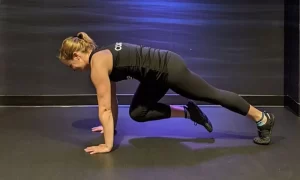
- Begin in a straight-arm plank position.
- Take your right knee to near your right elbow.
- Maintain it for a second, then go back to a regular plank.
- Change sides and Do it again for your chosen repetition count.
Before beginning any workout in a plank posture, be sure that the entire thing is in alignment. Your wrists should be under your shoulders as you start your plank. and Your back ought to lay flat, and your neck should be aligned with your spine (don’t curve that neck!). Your hips should also be aligned with your spine. Compress your buttocks and core, and remember to breathe. It’s fine if your knees don’t reach your elbows; simply go as far as you possibly can.
Standing Knee-to-Elbow Crunches
This is the best variation for those who are struggling with bicycle crunches or for those who are not able to lay on their back. If you increase the speed, this can also be an excellent addition to bodyweight cardio training.
In order to do this exercise follow the below steps
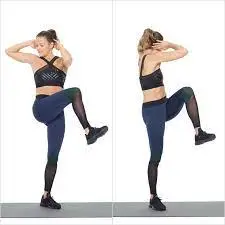
- Start from a standing position, bend your right arm, and rotate as you raise your left knee to meet it.
- Change and twist to take your left elbow to touch your right knee.
- Perform it again for the desired number of repetitions.
Russian Twists
For a more challenge, feel free to take a dumbbell or a medicine ball and keep it in your hands as you rotate to each side. If keeping your feet in the air is too hard, place them on the floor.
In order to do this exercise follow the below steps
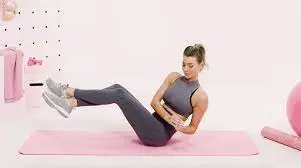
- Start with sitting up tall on your mat with your knees up.
- Raise your heels off the ground and start the exercise by twisting your torso to the right.
- Touch both of your hands to the surface of the ground.
- That is one repetition.
- Twist your torso to the left and touch the ground on the other side.
- That is another repetition.
- Continue to do this until you have finished your set.
Bear Crunches
Turning and getting that knee through to another side can be difficult at first. To begin, simply rotate and lower your hip on the surface of the ground. Lower your right hip to the ground, for instance, if you are twisting to the left. go back to the tabletop before switching.
In order to do this exercise follow the below steps
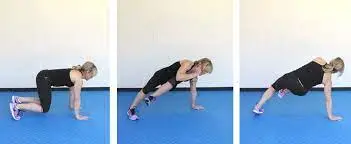
- Stay in a tabletop position and raise those knees an inch or two off the ground.
- Shift your weight onto your right arm then crunch your right knee into the chest as you turn your body to the left.
- Raise up your left arm and take your left elbow to touch your right knee.
- Come back to your neutral position and do it again on the other side.
Cross Chops
This is another best one to add to a cardio or HIIT workout. You can alter the difficulty level by adjusting the dumbbell’s weight.
In order to do this exercise follow the below steps
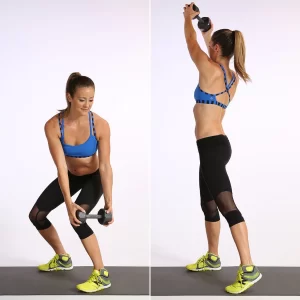
- Take a dumbbell and start in a standing position, feet a little wider than hip distance apart.
- Sit into a quarter squat and take the dumbbell to the outside of your right thigh.
- Raise and rotate as you stand to take that dumbbell above your head on the left.
- You can begin together continuous repetitions by moving in this direction or changing the direction for each repetition.
- Just make sure you are doing the same amount on each side.
Twist Jacks
This is great for warm-ups and other cardio-focused workouts.
In order to do this exercise follow the below steps
- Start in a standing position.
- Hop as you twist your shoulders and torso to the right as you bring your right leg forward, and left leg backward.
- Change and keep switching.
- Keep going until you have produced a sweat.
Side Jackknives
Take caution not to strain your neck excessively as you crunch. Rather, concentrate on bending and raising through the core. If you want to make it more difficult, attempt to raise both of your legs over the surface of the ground.
In order to do this exercise follow the below steps
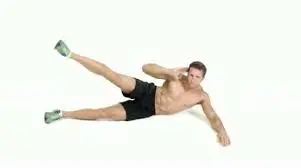
- Start with lying on your right side with your arm on the floor.
- Grab your head with your left arm.
- Raise your left leg as you crunch your left elbow toward the leg.
- Maintain for a second.
- Lower yourself down then do it again until you finish a set.
Extended Side Angle Pose
In order to do this exercise follow the below steps
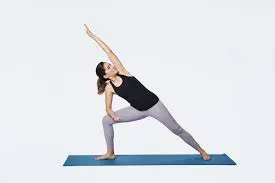
- Begin in a standing position.
- Place your hands on your hips and take a broad position with your feet.
- Rotate your right foot so it is pointing to your right.
- Bend your right knee and descend your body down into a lunge position.
- Your knee should be bent at a forty-five-degree angle, and not extending past your ankle, left leg is extended behind you.
- Bend your right elbow and place it on your right leg while turning your torso to face your left side, maintaining your head straight with your spine and facing your left.
- Raise your left arm up, palm down, and extend it beside your left ear, feeling the whole left side stretch.
- To make it more challenging, instead of resting on your knee, put your right hand on an object or all the way to the ground.
- Maintain for 30 to 45 seconds before switching sides.
Benefits of Strengthening Obliques
Strengthening the oblique muscles provides numerous benefits for overall health and fitness. These are a couple of the primary advantages:
Improved Core Stability: The obliques are an essential component of the core muscles, which include the abdominals, back muscles, and pelvic floor muscles. Strong obliques contribute to better core stability, which is crucial for maintaining proper posture, balance, and alignment. Core stability is particularly important in activities that involve twisting, turning, or carrying heavy loads.
Enhanced Athletic Performance: Strong oblique muscles can greatly improve athletic performance in various sports and physical activities. They provide power and stability during rotational movements, such as swinging a golf club or tennis racket, throwing a ball, or performing a twist in gymnastics. Strengthening the obliques can enhance the efficiency and power of these movements, leading to improved performance.
Injury Prevention: Weak oblique muscles can lead to imbalances in the core and lower back, increasing the risk of injuries. By strengthening the obliques, you can help prevent common injuries such as lower back pain, muscle strains, and hernias. The increased stability and support provided by strong obliques can also reduce the risk of falls and improve overall body mechanics.
Improved Functional Movement: The obliques play a significant role in everyday functional movements such as bending sideways, twisting, and reaching. Strengthening these muscles can make these movements easier and more efficient, improving overall functional fitness. Whether it’s picking up objects from the floor, carrying groceries, or playing with children, strong obliques contribute to better movement patterns and reduce the risk of strain or injury.
Aesthetics: Well-developed oblique muscles can contribute to a defined waistline and a more sculpted appearance. Strengthening the obliques can help tone and tighten the waist area, giving a more balanced and proportionate physique. However, it is important to note that spot reduction of fat in the abdominal area is not possible, and a combination of strength training, cardiovascular exercise, and a balanced diet is necessary for overall body fat reduction.
To fully reap the benefits of strengthening the obliques, it is important to incorporate a variety of exercises that target these muscles from different angles and movement patterns. This ensures that all areas of the obliques are adequately challenged and developed. Additionally, it is crucial to maintain proper form and technique during exercises to avoid strain or injury. Consulting with a fitness professional or trainer can help design a safe and effective oblique strengthening program tailored to individual needs and goals.
FAQ
What are the best exercises to strengthen the obliques?
Some effective exercises for oblique strengthening include side planks, Russian twists, bicycle crunches, woodchoppers, and standing side bends. It is important to incorporate a variety of exercises that target the obliques from different angles and movement patterns.
How often should I do oblique strengthening exercises?
The frequency of oblique strengthening exercises depends on individual goals and fitness levels. Generally, it is recommended to perform these exercises 2-3 times per week with at least one day of rest in between sessions to allow for muscle recovery.
Can I reduce fat in the abdominal area by strengthening my obliques?
No, spot reduction of fat is not achieved. While strengthening the obliques can help tone and tighten the waist area, overall body fat reduction requires a combination of strength training, cardiovascular exercise, and a balanced diet.
Are there any precautions or contraindications for oblique strengthening exercises?
Individuals with pre-existing lower back or spine conditions should consult with a healthcare professional before starting an oblique strengthening program. To avoid strain or damage, it is critical to maintain good form and technique throughout the exercises.
Can I do oblique strengthening exercises if I have a diastasis rectus (abdominal separation)?
If you have a diastasis recti, it is important to modify or avoid exercises that put excessive pressure on the abdominal wall. Consult with a healthcare professional or specialized trainer who can guide you in performing safe exercises that promote healing and strengthen the core without exacerbating the condition.
How long does it take to see results from oblique strengthening exercises?
The time it takes to see results from oblique strengthening exercises varies depending on individual factors such as genetics, consistency, intensity, and overall fitness level. With regular practice and proper nutrition, noticeable improvements in core stability and muscle tone can typically be seen within a few weeks to a couple of months.
Reference
- 30 Exercises to Make the Most of Your Oblique Workout. (2020, September 1). Healthline. https://www.healthline.com/health/fitness-exercise/oblique-workout#beginner-routine
- McCoy, J., & CPT, C. S. (2023, October 12). The 16 Best Oblique Exercises to Fire Up the Sides of Your Abs. SELF. https://www.self.com/gallery/obliques-exercises
- Jackson-Gibson, A. (2023, February 6). 15 Best Oblique Exercises for Women to Get Stronger Abs. Prevention. https://www.prevention.com/fitness/workouts/g30998256/best-oblique-exercises-1/
- Lawler, M. (2023, July 17). The Best Exercises for Stronger Obliques. EverydayHealth.com. https://www.everydayhealth.com/fitness/the-best-exercises-for-stronger-obliques/
- Image: Side jackknife. (2023, May 12). Men’s Health. https://www.menshealth.com/uk/fitness/a752902/side-jackknife/
- Image: Ryt, A. P. (2020, June 30). How to Do Extended Side Angle (Utthita Parsvakonasana) in Yoga. Verywell Fit. https://www.verywellfit.com/extended-side-angle-pose-utthita-parsvakonasana-3567116
- Image: Lefkowith, C. (2016, April 30). Strengthen Your Core With Standing Core Exercises – 20 Standing Core Exercises. Redefining Strength. https://redefiningstrength.com/20-standing-core-exercises/
- Image: lunge with rotation – The Kensington Studio. (2013, June 11). The Kensington Studio. https://thekensingtonstudio.wordpress.com/tag/lunge-with-rotation/
- Image: Leg Windshield Wipers. (n.d.). skimble.com. https://www.skimble.com/exercises/26064-leg-windshield-wipers-how-to-do-exercise
- Image: Lefkowith, C. (2016, December 12). Alternating V-Ups. Redefining Strength. https://redefiningstrength.com/alternating-v-ups/
- Image: May, S. (2018, May 3). Standing Elbow-to-Knee | Waist Exercises | POPSUGAR Fitness Middle East Photo 23. POPSUGAR Fitness Middle East. https://me.popsugar.com/fitness/photo-gallery/44802730/image/44802709/Standing-Elbow–Knee
- Image: Warwood, E. (2022, May 19). How To Do A Russian Twist To Really Fire Up The Core, According To Trainers. Women’s Health. https://www.womenshealthmag.com/fitness/a26011033/russian-twist/
- Image: Greco, A. (2016, November 6). bear-crunch – Square Box Fitness. Square Box Fitness. https://www.squareboxfitness.com/2016-shape-up-t4-week-4/attachment/bear-crunch/
- Image: De Medeiros, M. (2019, August 20). Dumbbell Cross-Body Wood Chopper | Compound Exercises For Fat Loss | POPSUGAR Fitness UK Photo 2. POPSUGAR Fitness UK. https://www.popsugar.co.uk/fitness/photo-gallery/46522275/image/46522262/Dumbbell-Cross-Body-Wood-Chopper
- Image: Standing Core Stabilization. (n.d.). skimble.com. https://www.skimble.com/exercises/30223-standing-core-stabilization-how-to-do-exercise
- Image: Astorino, D. M. (2018, February 7). How to Do Squats With Oblique Crunches | POPSUGAR Fitness. POPSUGAR Fitness. https://www.popsugar.com/fitness/how-do-squats-oblique-crunches-44483624
- Image: Side Plank With Reach Under. (n.d.). skimble.com. https://www.skimble.com/exercises/17445-side-plank-with-reach-under-how-to-do-exercise
- Image: Oblique / Cross body mountain climbers – GoFitnessPlan. (n.d.). GoFitnessPlan. https://www.gofitnessplan.com/exercises/oblique-mountain-climbers

